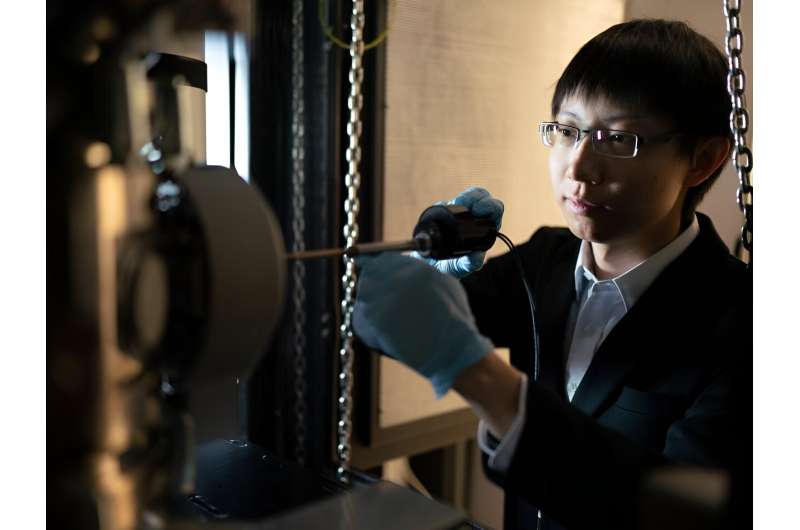This article has been reviewed according to Science X's editorial process and policies. Editors have highlighted the following attributes while ensuring the content's credibility:
fact-checked
peer-reviewed publication
trusted source
proofread
New structural insights could lead to mechanical enhancement in alloys

A new class of metallic materials with potential applications in airplane turbines, nuclear reactors and equipment for space exploration can withstand extreme temperatures and resist fractures, but scientists haven't understood why until now.
According to a new study co-led by Penn State researchers, the answer could relate to the material's short-range order, or the local arrangement of atoms within a material. This knowledge could lead to further improvement in the mechanical performance and damage tolerance of these materials, the researchers said, leading in turn to advancements in the safety and reliability of next-generation engineering systems for transportation or power plants.
Their results were published in Nature Communications.
The team developed a new imaging method to study the local atomic arrangement of the metallic materials, called high- and medium-entropy alloys (HEA/MEA), and focused their study specifically on the chromium-cobalt-nickel (CrCoNi) MEA and its impacts on mechanical performance.
"The mechanical performance of the CrCoNi is amazing," said co-corresponding author Yang Yang, Penn State assistant professor of engineering science and mechanics and nuclear engineering who is also affiliated with the Materials Research Institute. "For example, it has recently been shown to have the highest toughness on Earth at nearly -423°F. But people didn't know why it was so good."

Some scientists, Yang said, hypothesized that short-range order was responsible for this.
"But because the short-range order is so small and subtle in materials, it's very challenging to observe or measure it in order to provide experimental proof," said co-corresponding author Andrew M. Minor, professor of materials science and engineering at the University of California Berkeley (UC Berkeley) and Lawrence Berkeley National Laboratory (LBNL).
CrCoNi has three components: chromium, cobalt and nickel. Each element has the same atomic fraction within the alloy, and early studies assumed that each of the three kinds of atoms was randomly distributed within the system, according to Yang. However, Yang said that recent studies show the material actually displays short-range order.
"Let's imagine that there's a party with people from Penn State, Ohio State and North Carolina State," Yang said. "And, ideally, you'd expect everyone to mingle seamlessly, creating a uniform mix of individuals throughout the room. However, in practice, this isn't always the case. Often, people from the same university tend to gravitate towards each other, drawn by shared experiences. This is a kind of short-range order, deviating from the anticipated random distribution."
In order to study the role of short-range order in CrCoNi, the team designed an experiment using an energy-filtered 4D scanning transmission electron microscopy (4D-STEM) system. In a 4D-STEM experiment, a nanosized electron beam scans on the sample, generating a nanobeam electron diffraction pattern for each point.
According to Minor, they were able to capture hundreds of electron diffraction images every second, allowing them to analyze the evolution of material defects under stress with both a large field of view and high resolution.
"Defects are formed during the mechanical deformation process, and we actually found that there's a transition in the formation of a defect," Minor said, noting that they focused specifically on planar defects, or the "errors" in the stacking sequence of planes of atoms.
"We found that the planar defect is fully reversible during the initial cycles. If we deform it and then release the force, it fully recovers. However, after around a thousand cycle of mechanical deformation, this reversibility disappears. At that point the defect tends to stay there after we release the load. And this transition, we think, is actually governed by the short-range order in this system."
Yang said this is because at the beginning, the system has a lot of short-range order that makes the reversible processes favorable. However, the deformation gradually destroys this small ordering, and that tunes the deformation mechanism towards another one that favors this formation of a planar defect.
"The short-range order is like a moderator," Yang said. "The local density of it, or the degree of it, controls which mechanism is working, which is not working. The synergy of varied deformation mechanisms is critical for the high damage tolerance in this material class."
By successfully providing a technique to visualize planar defect evolution in CrCoNi and integrating advanced atomistic modeling, the researchers were able to reveal the interaction between short-range order and planar defects, which could enhance these alloys' mechanical performance.
More information: Yang Yang et al, Rejuvenation as the origin of planar defects in the CrCoNi medium entropy alloy, Nature Communications (2024). DOI: 10.1038/s41467-024-45696-z



















